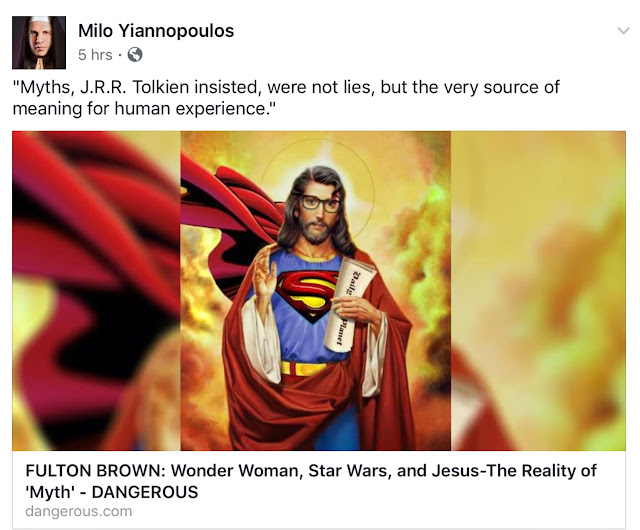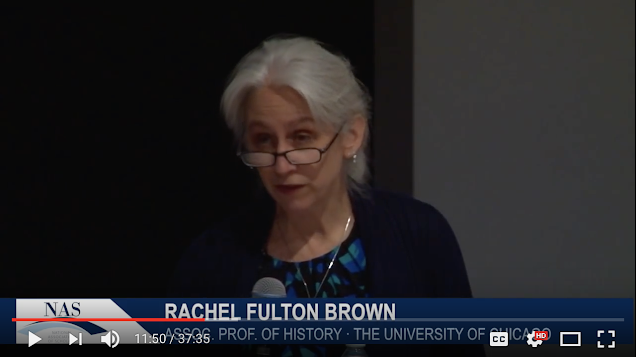Wonder Woman, Star Wars, and Jesus: The Reality of “Myth”
Another classic from the archive!
This article was originally published for Christmas, but the argument works for all Christian festivals, including All Hallows’ Eve.
What would it be like to find yourself inside a fairy-story? Would you wear the costume of a saint?
I have 1000 words to convince you to celebrate Christmas—or, as one of MILO’s Facebook fans put it, “The Jesus Myth.” Right.
I could try to convince you that Christmas is a fully Christian celebration, having nothing to do with supposed appropriations of pagan festivals, but that presumes that you care about celebrating Christmas as Christian in the first place. What I need to do is convince you that the myth matters as a myth.
This is not a comfortable thought for many modern Christians, used as we are to the accusation that we worship a fairy-tale sky god. If you are a Protestant, you can blame Rudolf Bultmann (d. 1976), the great German Biblical scholar famous for attempting to “de-mythologize” the New Testament. If you are a Catholic, you can still blame the Protestants; they have been accusing Catholics of superstition since the year dot of the sixteenth-century Reform.
And, indeed, if you read the New Testament carefully, it is hard not to argue that Bultmann may have had a point.
The tri-partite structure of the cosmos with earth in the middle, heaven above, and hell below; the on-going battle between God and his angels on one side, Satan and his demons on the other; the role of visions in communicating with humanity and the supernatural interventions of God’s Spirit; the expectation of the cosmic catastrophe to come with the return of the heavenly judge, the resurrection of the dead, and the final judgment of souls: “all of this,” Bultmann insisted, “is mythological talk…incredible to men and women today”—Bultmann was writing in 1941—“because for them the mythical world picture is a thing of the past.”
You don’t say. Have you been to any movies lately? Star Wars, for example. Or maybe something out of Marvel or DC. I particularly enjoyed Wonder Woman, but Guardians of the Galaxy is also good. Didn’t you love how Wonder Woman is a goddess, armed with a lasso of truth, and how she is the only one who can defeat Ares, the god of war? And how Captain Steve Trevor (spoiler alert!) is willing to sacrifice himself so that she can concentrate on fighting Ares?
No Christian mythology here, right? Right.
Professor of Church History at Garrett-Evangelical Theological Seminary James L. Papandrea explains: “For many people, the familiar Marvel and DC superheroes are the most obvious Christ figures [in modern science fiction] because they are, in their essence, saviors.” Wonder Woman may be modeled on a pagan character—she is an Amazonian princess—but the role that she plays is quintessentially Christian, if unorthodox.
As a goddess, Wonder Woman descends to earth like Christ to rescue humanity from its sins, but it is Captain Trevor who dies, not Diana. In Christological terms—this is your ten-dollar word for the day; it means “talking about Christ”—Wonder Woman is a gnostic savior, like Superman. Although in the movie, she is said to be half-human, half-divine (the daughter of Zeus with Hippolyta, the Amazonian Queen), her role is not to sacrifice herself, but to bring wisdom. She exposes Sir Patrick Morgan as Ares, as well as his role in encouraging the war.
Here’s the question: why do we care? The studios spent millions and millions of dollars on making these movies as “realistic” as possible, when the driving force behind them is unquestionably myth. You will say, nobody worships Diana or Ares. But they used to. And to judge from the power of these stories to shape our culture even in the present day, to a certain extent, we still do.
J.R.R. Tolkien thought he knew. Once upon a time, he wrote a poem for his friend C.S. Lewis, who still believed that “myths were lies and therefore worthless, even though ‘breathed through silver.’” Myths, Tolkien insisted, were not lies, but the very source of meaning for human experience. Without myths—that is, the exercise of human story-telling—there are no trees or stars, and no firmament
only a void, unless a jewelled tentmyth-woven and elf-patterned; and no earth,unless the mother’s womb whence all have birth.
Further, Tolkien argued, human beings respond to myth because we are made in the image and likeness of a Maker:
Though all the crannies of the world we filledwith elves and goblins, though we dared to buildgods and their houses out of dark and light,and sow the seeds of dragons, ’twas our right(used or misused). The right has not decayed.We make still by the law in which we’re made.
How is it that even story-tellers who do not think of themselves as Christian end up telling stories about Christ figures? Because, as Papandrea explains following Tolkien, “when we create art, it bears the stamp of our Creator too. Even people who don’t believe in God end up writing about God.”
Psychologist Carl Jung (d. 1961) called these kinds of stories archetypes and believed that he could prove they existed in what he called humanity’s collective unconscious. As Jung would have it, it does not matter whether we believe the archetypes, they work on us whether we like it or not. You may not believe in these “lies breathed through silver”—but these stories believe in you.
In Tolkien’s words, the Gospels contain not just a good story. They contain
a fairy-story, or a story of a larger kind which embraces all the essence of fairy-stories…. There is no tale ever told that men would rather find was true, and none which so many sceptical men have accepted as true on its own merits…. Because this story is supreme; and it is true. Art has been verified. God is the Lord, of angels, and of men—and of elves. Legend and History have met and fused.
Give it a try, I dare you. Find another story that gives meaning to your life that does not involve a savior. And then ask yourself what you would give to find that that story was true.
See what I mean?
Merry Christmas!
Source: J.R.R. Tolkien, Tree and Leaf, including Mythopoeia (Hammersmith: HarperCollins, 2001).
—Originally published December 26, 2017, on Dangerous.com. Reprinted with permission.
For more on the way in which Milo points us to the fairy-stories of Christianity, see The MILO Chronicles.






I loved reading this. Thank you.
ReplyDeleteYour Student in Gratitude,
Amber
Now that I'm out of the car, I would like to write a more articulate reply.
DeleteAs someone who settled into the center after a brief but passionate affair with left, I'm relearning respect for all of the traditions that I had previously scorned. I wasted a lot of my youth, gifts and patience placating some of the more volatile mini-Stalin types. It felt a little bit like being in a codependent relationship where your politics define your identity, and your identity must shift, adapt and change to be most pleasant to the others.
As you know, Rachel, I received my bachelors degree from The Evergreen State College in Olympia, WA in 2017. (That was the year my graduating class had to walk across the field at Cheney Stadium instead of Red Square.) I was pretty heavily involved in the local stand-up comedy scene as well. I did an open mic every week or so in 2015. Around that time all of my friends were either actors or comics, so it should go without saying that I was pretty lonely.
One of the things I noticed, through all of this, was that we all tended to #resist along the path of least resistance. It was seductive because it felt intuitive, like a long-lost spiritual truth. I gave so much to that place, but what I thought was good will towards building a new, unique community was just mindful self-indulgence. I wanted to be a hero of my own story, like everyone else. But I guess when everyone is a messiah, no one is.